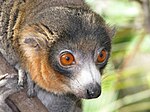The Primates Portal A primate is a member of the biological order Primates, the group that contains lemurs, the aye-aye, lorisids, galagos, tarsiers, monkeys, and apes, with the last category including great apes. With the exception of humans, who inhabit every continent on Earth, most primates live in tropical or subtropical regions of the Americas, Africa and Asia. Primates range in size from the 30-gram (1 oz) pygmy mouse lemur to the 200-kilogram (440 lb) mountain gorilla. According to fossil evidence, the primitive ancestors of primates may have existed in the late Cretaceous period around 65 mya (million years ago), and the oldest known primate is the Late Paleocene Plesiadapis, c. 55–58 mya. Molecular clock studies suggest that the primate branch may be even older, originating in the mid-Cretaceous period around 85 mya. Primates exhibit a wide range of characteristics. Some primates do not live primarily in trees, but all species possess adaptations for climbing trees. Locomotion techniques used include leaping from tree to tree, walking on two or four limbs, knuckle-walking, and swinging between branches of trees (known as brachiation). Primates are characterized by their large brains relative to other mammals. These features are most significant in monkeys and apes, and noticeably less so in lorises and lemurs. Many species are sexually dimorphic, which means males and females have different physical traits, including body mass, canine tooth size, and coloration.
Selected article
Lemurs are an infraorder of strepsirrhine primates that is endemic to the island of Madagascar. Although lemurs often are confused with ancestral primates, the anthropoid primates (monkeys, apes, and humans) did not evolve from them; instead, lemurs merely share morphological and behavioral traits with basal primates. Lemurs arrived in Madagascar approximately 62 to 65 mya by rafting on mats of vegetation at a time when ocean currents favored oceanic dispersal to the island. Since that time, lemurs have evolved to cope with an extremely seasonal environment and their adaptations give them a level of diversity that rivals that of all other primate groups. Until shortly after humans arrived on the island approximately 2,000 years ago, there were lemurs as large as a male gorilla. These subfossil lemurs were all larger than species living currently. Today, there are nearly 100 species of lemurs, and most of those species were discovered or promoted to full species status since the 1990s; however, lemur taxonomic classification is controversial and depends on which species concept is used. Living lemurs range in size from 30 g (1.1 oz) to 9 kg (20 lb). Lemurs share many common, basal primate traits, such as divergent digits on their hands and feet and nails instead of claws (in most species). However, their brain-to-body size ratio is smaller than that of anthropoid primates, and among many other traits they share with other strepsirrhine primates, they have a "wet nose" (rhinarium).
Selected picture The ring-tailed lemur (Lemur catta) is a large strepsirrhine primate and the most recognized lemur due to its long, black and white ringed tail. It belongs to Lemuridae, one of five lemur families, and is the only member of the Lemur genus. Like all lemurs it is endemic to the island of Madagascar. Known locally in Malagasy as maky (spelled maki in French) or hira, it inhabits gallery forests to spiny scrub in the southern regions of the island. It is omnivorous and the most terrestrial of lemurs. The animal is diurnal, being active exclusively in daylight hours. CategoriesSelected species Critically Endangered (IUCN 3.1)|Critically endangered The silky sifaka or silky simpona (Propithecus candidus) is a large lemur characterized by long, silky white fur and has a restricted range in northeastern Madagascar. It is one of the rarest mammals on earth, and is listed by the International Union for Conservation of Nature (IUCN) as one of the world's 25 most critically endangered primates. The silky sifaka is one of nine sifaka species (genus Propithecus), and one of four former subspecies of diademed sifaka (P. diadema). The silky sifaka has a variable social structure, and lives in groups of two to nine individuals. It spends most of its day feeding and resting, though it also devotes a considerable amount of the day to social behaviors, such as playing and grooming, as well as traveling. Females take priority over males during feeding. The diet consists primarily of leaves and seeds and is highly varied, consisting of many plant species. It is a seasonal breeder and only mates one day a year. Parental care is shared among adults in the group, as it is with other sifaka species. Like all lemurs, it relies strongly on scent for communication, often scent-marking trees near the center of its home range, as opposed to the territory borders. The species is only found within a few protected areas in the rainforests of northeastern Madagascar, with the majority of the remaining population in Marojejy National Park and Anjanaharibe-Sud Special Reserve. The silky sifaka is hunted throughout its range as there is no local taboo (fady) against eating this species. Habitat disturbance, such as slash-and-burn agriculture (tavy), illegal logging of precious woods (particularly, rosewood) and fuel-wood, also occurs within the protected areas where it is found. Did you know?
Primate lists
WikiProjectsThings to do
Associated WikimediaDiscover Wikipedia using portals |
















